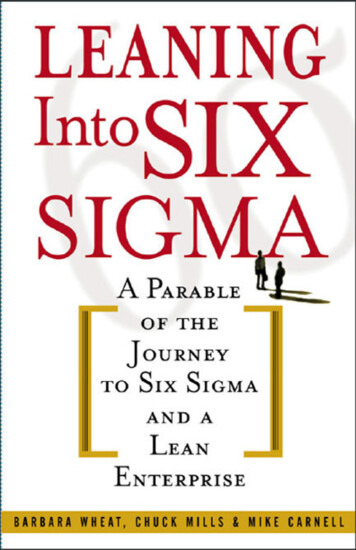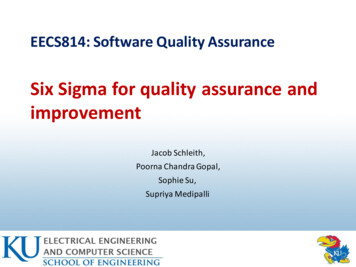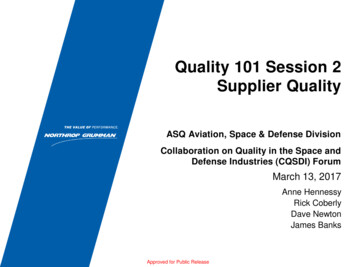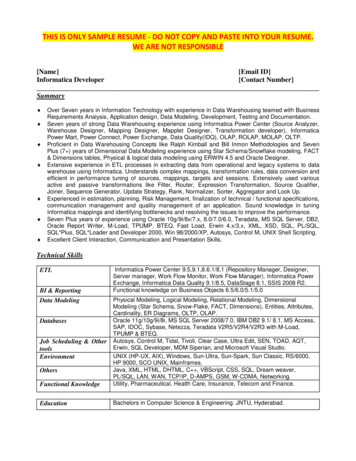
Transcription
Leaning intoSix SigmaWarning:Reading this book could result in effective changeoccurring in your organization.
This page intentionally left blank.
Leaning intoSix SigmaA Parable of the Journey toSix Sigma and a Lean EnterpriseBarbara WheatChuck MillsMike CarnellMcGraw-HillNew York Chicago San Francisco LisbonLondon Madrid Mexico City Milan New DelhiSan Juan Seoul Singapore Sydney Toronto
Copyright 2003 by The McGraw-Hill Companies, Inc. All rights reserved. Manufacturedin the United States of America. Except as permitted under the United States Copyright Actof 1976, no part of this publication may be reproduced or distributed in any form or by anymeans, or stored in a database or retrieval system, without the prior written permission of thepublisher.0-07-142894-1The material in this eBook also appears in the print version of this title: 0-07-141432-0All trademarks are trademarks of their respective owners. Rather than put a trademarksymbol after every occurrence of a trademarked name, we use names in an editorial fashion only, and to the benefit of the trademark owner, with no intention of infringement ofthe trademark. Where such designations appear in this book, they have been printed withinitial caps.McGraw-Hill eBooks are available at special quantity discounts to use as premiums andsales promotions, or for use in corporate training programs. For more information, pleasecontact George Hoare, Special Sales, at george hoare@mcgraw-hill.com or (212) 9044069.TERMS OF USEThis is a copyrighted work and The McGraw-Hill Companies, Inc. (“McGraw-Hill”) andits licensors reserve all rights in and to the work. Use of this work is subject to these terms.Except as permitted under the Copyright Act of 1976 and the right to store and retrieve onecopy of the work, you may not decompile, disassemble, reverse engineer, reproduce, modify, create derivative works based upon, transmit, distribute, disseminate, sell, publish orsublicense the work or any part of it without McGraw-Hill’s prior consent. You may usethe work for your own noncommercial and personal use; any other use of the work is strictly prohibited. Your right to use the work may be terminated if you fail to comply with theseterms.THE WORK IS PROVIDED “AS IS”. McGRAW-HILL AND ITS LICENSORS MAKENO GUARANTEES OR WARRANTIES AS TO THE ACCURACY, ADEQUACY ORCOMPLETENESS OF OR RESULTS TO BE OBTAINED FROM USING THE WORK,INCLUDING ANY INFORMATION THAT CAN BE ACCESSED THROUGH THEWORK VIA HYPERLINK OR OTHERWISE, AND EXPRESSLY DISCLAIM ANYWARRANTY, EXPRESS OR IMPLIED, INCLUDING BUT NOT LIMITED TOIMPLIED WARRANTIES OF MERCHANTABILITY OR FITNESS FOR A PARTICULAR PURPOSE. McGraw-Hill and its licensors do not warrant or guarantee that the functions contained in the work will meet your requirements or that its operation will be uninterrupted or error free. Neither McGraw-Hill nor its licensors shall be liable to you or anyone else for any inaccuracy, error or omission, regardless of cause, in the work or for anydamages resulting therefrom. McGraw-Hill has no responsibility for the content of anyinformation accessed through the work. Under no circumstances shall McGraw-Hilland/or its licensors be liable for any indirect, incidental, special, punitive, consequential orsimilar damages that result from the use of or inability to use the work, even if any of themhas been advised of the possibility of such damages. This limitation of liability shall applyto any claim or cause whatsoever whether such claim or cause arises in contract, tort orotherwise.DOI: 10.1036/0071428941
For more information about this title, click troductionSG, Inc.First Impressions of the PlantWorkplace Organization and the Five S’sThe Results of Five S ImplementationSix Sigma Strategy for SidDefining Six SigmaImplementing Six SigmaThe Crow’s NestA New CommitmentLean: Listening to the ProcessFull Circle: Lean to Six Sigma to Lean to Six SigmaGetting Organized to Get Me OutIndexCopyright 2003 by The McGraw-Hill Companies, Inc. Click Here for Terms of Use.viiix141321243033374650587481v
This page intentionally left blank.
ForewordThe Six Sigma concept and Total Cycle Time (Lean Enterprise)were two of the key initiatives undertaken by Motorola backin the mid-1980s that I was fortunate enough to be a part of.This continuous improvement methodology works, as evidenced bythe fact that many companies and quality consultants are deploying itcorrectly. Even the worldwide organization of the American Societyfor Quality will be establishing a new certification exam for Six SigmaBlack Belts, which truly demonstrates how institutionalized the SixSigma process has become.This is the type of book you want every company employee,especially executive leaders and middle managers, to read before youstart your Lean/Six Sigma deployment. Everyone effects change in anorganization and can relate to the various characters and their roles inthis book.The authors have done an excellent job explaining in a non-technical way the Six Sigma problem-solving methodology, MAIC(Measure, Analyze, Improve, and Control), and why it is critical that itbe linked to the Five S’s of Lean Enterprise.This modern day fable, which can be read on your next shortflight, depicts the “typical company” looking for a solution to chronicquality issues and a month-end delivery bottleneck, patched up withsignificant overtime and resulting in poor financials.Copyright 2003 by The McGraw-Hill Companies, Inc. Click Here for Terms of Use.vii
viiiForewordSam is invited to visit the plant owner to help him make the decision on which machine to buy. Sam runs into a typical mess everywhere she looks in the company, including your doubting Thomas(the manufacturing supervisor, George), who has been there since thedoors opened and helped the owner to build the business to what itis today.As they work with the “problem child department team,” usingthe Five S’s and deploying MAIC problem-solving methodologies,both Sid and George come to realize the need for change—and evenbecome strong advocates and champions for that change.An exit strategy for Sam is developed, so that the ownership ofthe new problem-solving methodologies is internalized and institutionalized by the company’s leadership and staff. The end comes so quickly you are left wondering what happens next.I strongly urge anyone who is thinking of deploying the Lean/SixSigma methodology to read this book. Based on the “real life” comments and examples used, it is evident that the authors have livedwhat they are preaching, successfully deploying Lean/Six Sigma in alltypes of applications, including manufacturing, service industries,financial institutions, government, research and design development,and aerospace.The book captures the true spirit of Six Sigma and continuousimprovement that made Motorola great and I am sure it will be appreciated by all implementing or looking to implement a Six Sigmadeployment today.—John A. LupienskiMotorola, Inc.
IntroductionI’m “that guy.”I haven’t always been that guy. It’s a relatively new position forme. I joined the ranks of “those guys” only a few years ago.You know us: we’re the people your boss hires to help youaddress issues in your organization for which you already know thesolution. Yep, that’s me—one of those “damned consultant guys.” I’mfemale, but that doesn’t make a difference: “those consultant guys” aregender-neutral. So, I’m “that guy.”I know how you might feel. Someone comes into your workplace,asks a bunch of questions, and then puts your responses into a nicelypackaged format and delivers to your boss a report that is a mirrorimage of your solution to the problem.So, why does an organization pay for information it already has?Let’s start examining this issue with a personal example of the phenomenon—me.By the way, the name is Sam. Well, my parents, Mr. and Mrs.Micawh, named me Samantha, but that’s a little fancy—especially inmy world.I work primarily in manufacturing. In fact, my informal title is“plant rat.” Clients and colleagues have given me that title and I’mquite proud of it. I’m one of those very odd individuals who love the“real” problems that only a factory can provide.Copyright 2003 by The McGraw-Hill Companies, Inc. Click Here for Terms of Use.ix
xIntroductionSo, you may be wondering, why would someone who loves thefactory and “real” problems leave her job to become one of “thoseguys”?I was actually very happy with my last position before becoming“that guy.” I worked as part of a team to solve chronic problems in ourplant. Our team was great at solving problems. In fact, finding solutions quickly became the easiest part of my job.But here’s the catch. Solving problems requires a scientificapproach based on data. Since the problems were costing the company money, it would seem logical to assume that the company wouldprovide the support required to solve the problem, right? Yeah, right!Every step toward implementing the solution of any problem is atrial by fire. It’s like making your way through a political minefield: yousoon wonder why you decided to attempt it without a map showingwhere the mines are and how to avoid them. But luckily (or so youwould think!) you live through the politics, you fix the problem, andyou get the satisfaction of a job well done. Sure, you don’t get a rousing rendition of “Hail the Conquering Hero” for meeting the challenge, but it feels good.As you explain to your team that their credibility is growingthroughout the organization, you wonder to yourself just how long itwill take to see. But since this project was so important and the solution was so elegant, you’re positive that after this victory you’ll nolonger have to fight political battles to solve problems.Then it comes as a complete surprise, of course, that othersthroughout the organization just don’t see the situation quite the sameway you do.So what do you do? Well, if you’re me, you quit fighting. You walkaway from that scene. I was tired of fighting for what I knew was right.I was ready to join an organization that had recognized my problemsolving skills, an organization where politics take a back seat to business decisions.Of course, as I walked away after submitting my resignation to my
Introductionxiboss, voices rose here and there, each a variant on one of twothemes—“Don’t quit now” and “You’ll be sorry.”As I walked out the door for the last time, I couldn’t miss the looksthat were trying to tell me I was making a big mistake.Well, I didn’t think so at the time—but I wasn’t so sure a few dayslater. As I was going through the interview process with that organization that I thought would be different, I began to realize that my exboss was right. No matter who you talk to, it seems there is a definitepolitical force in any organization that can lead to poor business decisions based mainly on politics.So, what do you do? The only thing left for me at that point wasto fight the politics on my own. I decided to hang out my “Consultant”shingle.But in joining the ranks of “those guys,” I quickly realized that theprofession had become contaminated. Being a consultant is almost asbad as being a lawyer, judging from the number of “bottom feeder”jokes flying around the business world.Nevertheless, I was committed to changing things. I vowed to bethe best consultant ever. There would be no shades of gray in mypalette of business ethics—only black and white, good and bad, “yes,it’s right” or “no, it’s wrong.” OK, you get the picture: there would beno “little white lies” for me.Things went pretty well for a while. I managed to build up a strongrelationship with my clients. In fact, I soon had more business than Icould handle—not a bad position for a consultant. This honesty thingreally works!I could tell you a lot of stories about being a consultant, but thisone’s the best.One day I get a call from my old boss. It seems the company hascome up against a problem they cannot solve without me and theywould like to hire me to consult.Can you believe it? At 65K per year as an employee, I had toscratch, fight, and fend for myself. Now at 3K per day, I get hired by
xiiIntroductionthe same team of leaders—who are now willing to step up to any solution I propose as though it’s an epiphany from above. I couldn’t helpbut wonder, “What’s wrong with this picture?”But I know the solution to the problem and the best approach toimplement the solution. Only this time, without the political constraints, I reach a conclusion in about a tenth of the time it would havetaken before, when I was an employee and not a consultant. Are yousurprised?I mentioned that consultants generally get a bad rep. But sometimes it’s the opposite: there’s a certain mystique. In fact, I could makemore money if I played the part of the guru. But, like I said, I’m committed to changing things and to being straight about it.So, my business went along pretty well for a while, until I ran intomy first big challenge as a consultant. I got a client who knew therewas a problem, but didn’t know what or where it was. I went throughthe process of determining the root cause and I planned and strategized for containing and eliminating the problem.But the client didn’t want to follow my recommendation. The topmanagers were not happy with the solution because it involved morecultural buy-in than the company was willing to commit to. Theywanted to pay me a little more for an easy fix: “Just make this thinggo away as quickly as possible.”Unfortunately, easy fixes sometimes cause more problems thanthey solve. There are several types of “easy fix” solutions, basically finger-in-the-dike stopgaps. You can cut costs, reorganize (again), centralize, decentralize . . . and all of this amounts to continuous firefighting,a continuing approach to greasing any wheel that squeaks—withouttaking the wheels apart to get at the causes of those annoying squeaks.You may make some short-term improvements here and there, butyou know it’s not enough and you can bet additional issues will ariseelsewhere in the organization in the near future.But I’m getting ahead of myself here. This book tells the story ofthat client, my biggest challenge—so far!
Chapter 1SG, Inc.Afew months back, a man named Sid Glick, president of amanufacturing company called SG, Inc., phoned my office.He asked if I could have lunch with him to discuss a problem he was having at his plant.We agreed to meet at his favorite home-cooking café. After theusual pleasantries, Sid blurted, “I called you, Ms. Micawh, because youwere highly recommended by some colleagues of mine who told methat you know your stuff, that you’re a plant rat who can take care ofthe problem.”Sid got straight to the point. I like that approach!“Good. But please call me Sam.”“OK, Sam,” he nodded, “here’s my situation. SG, Inc. manufactures machine components. We can make whatever parts our customers want—gears, valves, pistons, and so on—and we do assembly. Iwon’t bore you with details at this point. Now, here it is: I’m considering purchasing a five-axis CNC machine to the tune of 1,200,000or a smaller, four-axis machine for 750,000.”Copyright 2003 by The McGraw-Hill Companies, Inc. Click Here for Terms of Use.1
2Chapter 1I immediately imagined the two CNC machines side by side, witha big yellow price tag on each. (In case you’re not a “plant rat” like me,I should probably explain that CNC means “computer numericallycontrolled,” which just means that a machine tool is operated by a dedicated computer that has the capability to read computer codes andconvert them into machine control and driving motor instructions.)I listened attentively as Sid presented his situation.“I would like you to evaluate my backlog, our part configurations,and the run rates on these machines and then help me to determinewhich would be the smarter buy.”He slid a file across the table to me.It was refreshing to meet a person who had apparently done hishomework. Sid had determined the root cause of his capacity problem and had narrowed his options to these two machines. I agreed todo lunch with him the following Tuesday.I reviewed all of the materials Sid gave me, in just an hour or so.I guess I should have known it wasn’t going to be that easy. But sometimes even a hardened consultant like me just wants to believe.After we met at the restaurant, sat down, and ordered, Sidjumped right into it.“OK, Sam, you’ve read all the numbers, so you know about oursituation and the two machines. Now, give me your best guess—thefive or the four?”“I would rather not guess, Sid. That’s just not my style.”I paused. Sid seemed to appreciate that I was candid and blunt,so I continued.“I’d like to look at the plant and review the data that’s brought youto this point. Then, when I understand why you’re trying to decidebetween the five-axis or the four-axis, I can be sure of offering you thebest advice I can give.”Our sandwiches and coffee arrived and we started eating. Sid toldme he would be glad to show me through the plant. But, he explained
SG, Inc.3between bites, there was no specific data prompting the decision. Infact, he pointed out, that’s why he was consulting with me.“Hmm,” I thought, chewing a little more slowly. “That doesn’tsound good.” But I let it pass—for now. I hoped that my silence wouldget more out of Sid at this point than any questions. The tacticworked.“Actually,” he continued, taking a sip of coffee, “it’s George whosays we need a new machine.” He explained that George was theplant supervisor, who had been working at SG, Inc. for 26 years.“George says that’s the only way we can reduce our backlog andstart meeting delivery schedules. So,” he concluded, pushing his plateto the side, “that’s why I’ve asked you to help me decide betweenthese two machines.”“Oops!” I thought. SG, Inc. is about to decide on a million dollarcapital expenditure based on “tribal knowledge,” with no data to substantiate the decision. My lunch suddenly became unsettled, so as wewere at the counter paying the lunch tab, I bought some antacids.Key Points It’s a sign of problems when management is making decisionswithout specific data to support them. “Tribal knowledge”—although it can be a starting point inmaking decisions—is generally not enough in inself for smartdecisions, especially since this “knowledge” may be only abelief or a feeling or simply a hope.
Chapter 2First Impressionsof the PlantWe sometimes can't see the forest for the trees.As we drove up to the plant, my first thought was that Sid haddone a good job picking out a location for his company.Instead of one single building, SG consisted of two moderately sized side-by-side structures. The two facilities were connectedby a paved path with trees and shrubs planted on either side to makethe walk between the two buildings more pleasant. The landscapingwas nicely manicured and reminded me more of a park than a manufacturing location. The buildings were clean and the lawns weregroomed professionally. In the back of my mind, I was thinking, “OK,I could spend a week or two working in this environment.”As Sid motioned me into the visitors’ parking area, I caught sightof something that might have been a problem, but I decided to keepmy thoughts to myself until I saw the rest of the plant. Still . . . in theback of my mind was this nagging thought: “Why would an organization this small need to have all those tractor trailers parked back there?There’s no way they can be moving that much material in and out ofthis place.”4Copyright 2003 by The McGraw-Hill Companies, Inc. Click Here for Terms of Use.
First Impressions of the Plant5As soon as we hit the front door, a small, middle-aged woman ina snappy business suit met Sid. Before I was even introduced, itbecame apparent that this was his secretary.I knew I’d better make a good impression on this woman, becauseI’ve found over the past few years that plant managers and businessowners think they run the place, but the secretaries and administrativeassistants are the ones who really keep things going. If I wanted to doany type of business with Sid, I’d better make sure this woman likedme. In order to make sure, I slapped on my best smile and extendedmy hand to introduce myself.“Hello, ma’am, my name is Sam,” I said, “and who might you be?”The no-nonsense look she gave me said she wasn’t going todecide she liked me just because I smiled and took the initiative tointroduce myself. Within the blink of an eye, her words confirmedwhat her look suggested.“Well, I might be Joan of Arc,” she said without the slightest hint ofa smile, “but I am Celia Gordon. I’m Sid’s executive administrative assistant.”“Damn,” I thought. “That didn’t go as planned.” Luckily she was ina hurry and scurried away without even a whisper of goodbye.Sid just looked at me and shrugged.“She’s always like that. Just ignore it and she’ll warm up to you.”I didn’t say a word; I just smiled. I wanted to tell him that it wouldtake a bottle of acetylene and a blowtorch to warm that woman up.But, like I said, I didn’t say a word. I just stood there and smiled.Then we walked to Sid’s office. There Sid introduced me toGeorge, the manufacturing supervisor. This was the same George hehad mentioned in the restaurant, who had told him to buy the newpiece of equipment.George shook my hand and said, “Pleased to meet you,” and weentered Sid’s office.As we sat across the table from each other, George began telling me
6Chapter 2the history of Sid’s business. It was evident that George was very proudof the fact that he was one of only a handful of people left in the company who had been there since the very beginning.As George went through the history of SG, I realized that he hadgood reason to be proud. In under 30 years, the company had grownfrom two guys machining parts to an organization with over 500 fulltime employees and more than 300 million in sales annually. Theywere well respected in their industry, although recent quality concernsand late delivery issues were causing problems with some of theirbiggest contracted customers. These problems, however, could befixed with the new equipment. George had no doubts about that, andI certainly wasn’t going to say otherwise—at least not yet.As George wrapped up his history lesson, Sid suggested that Imight like to see the facility. George was between production meetings and said he would be happy to show me the plant.As we walked into the facility, I had mixed emotions. The consultant part of me was screaming at all the things I saw wrong and I feltan immediate urge to point everything out to George as we passedby. But the (semi) human side of me screamed that this would bewrong. Looking at him and listening as he showed me the variousprocesses throughout the plant, I decided to listen to my human sidefor a change.One thing that I couldn’t be quiet about, though, was the level ofnegativity I sensed as we walked through the plant. As we passed,operators stared at us or just scowled. I wasn’t sure which I foundmore unsettling.I asked George if SG had some labor problems and he just nodded. I decided to take the issue up with Sid later, after the tour.When the plant tour was over, George led me back to Sid’s officeand shook my hand at the door.“I’m really glad you came to have a look at the place,” he said.“Since Sid will have the opinion of an outsider now, I’m sure he’ll listen to me.”
First Impressions of the Plant7Then George walked away. I realized that he was telling me thatwhen I gave Sid the same recommendation as he had, Sid wouldbuckle and get the new equipment. Whoops! This was going to be aproblem, because I had no intention of advising Sid that he needed anew piece of equipment. Not yet, anyway.As I slowly opened the door to Sid’s office, I saw that he was on thephone. He motioned me to come in and have a seat. I sat down andbegan looking around at the plaques on the wall. Several were fromsuppliers for outstanding quality, cost reduction, and on-time delivery—but none of the plaques had a date less than 10 years old. Not a verygood sign, but I didn’t say a word about it to Sid as he hung up thephone. I just made a mental note.“Well, waddya think?” he asked me. “Can I get by with the smaller machine or should I just bite the bullet and go all out?”Sid spoke with such blatant pride that I almost didn’t have theheart to tell him what I’d seen. Almost.“You know, Sid, it may be possible to raise your quality and capacity levels without buying new equipment. If you would like, I can takea few minutes to give you my impressions of the facility. Then we cantalk about some less expensive ways to bring your quality up and yourcycle time down using the equipment you already have.”Sid smiled and said he liked the sound of that, so I asked him fora few minutes to get my thoughts together and write some notes. Sidsaid that was perfect, because he had a meeting scheduled that shouldtake about an hour. He asked Celia to find me a quiet space so I couldwork and said he’d meet me back in his office around 4:30.Judging by our first greeting, I expected Celia to put me somewhere in a cleaning closest filled with plenty of toxic chemicals.Instead, she showed me to a small conference room with a visitors’desk and a phone and told me where I could find the rest rooms, thesnack bar, and smoking areas. A definite improvement from earlier inthe day and I even thought I saw a hint of a smile as she turned toleave. But it was probably just the light playing tricks on me.
Chapter 28When I sat down to collect my thoughts, I realized that my impressions were even worse than I had consciously realized. Without thethreat of George knocking me on my butt, the truth of what I sawcame out pretty freely—and the truth was ugly. The word “ugly” stuckin my mind.I remembered that when I got started in consulting, a friend in thebusiness told me, “You never want to tell the customer he has an uglybaby.” That was his not-so-charming way of saying that you don’t badmouth the customers’ processes or initiatives—especially when they’veattempted to instill a positive improvement.I tried to keep that in mind as I prepared my notes, but it wasn’teasy. Sid had an ugly baby.At exactly 4:30 p.m., I walked out of the conference room andheaded toward Sid’s office. About 20 feet from the door, George calledfrom behind, “Hey, Sam, wait up.” He jogged the few steps to catch upwith me and said, “Hope you don’t mind, but Sid asked me to join you.”Sid was waiting and looked eager, so I began talking as soon aswe had exchanged pleasantries. Now, sensitive I’m not. If I were, Iwould have noticed the look on both their faces as I waded deeperinto my impressions of the facility. When I was finished running downmy laundry list of things that were wrong, I looked up at them andwas genuinely amazed by the shocked look in their eyes.I immediately looked down at the scribbled notes in my lap to seewhat I had said that would have been so devastating to the two men: The plant is filthy.There’s no control of parts that don’t meet specifications.There’s no semblance of lot control for work in process or finished goods inventory.Operators are performing their work sloppily and to no particular standard.There’s no apparent flow to the processes.There’s so much inventory that no one knows what they haveand what they don’t have.
First Impressions of the Plant 9There are excess and broken tooling and fixtures scatteredeverywhere in the plant.The lighting is very poor and work conditions are unsafe.All raw inventory is contaminated and there is no sure methodof controlling inventory. Raw material is stored alongside theproduction lines and appears to have been there for years.Material handlers are running all over the plant with nothing ontheir forklifts, wasting gas and endangering each other and theprocess operators.Hazardous material is not stored properly.There are years of inventory on trailers out back. (This is whatI was afraid of when I parked earlier in the day.)The few control charts scattered about the plant are outdatedby months—but no one is even looking at them anyway, thankgoodness!The processes are producing in batches because the setup timesare so long.The last processes before final inspection are being starved forpart assemblies for hours because of the batch and queuemethods.People are standing all over the plant waiting for something todo.Uh-oh, maybe I’d gone a little overboard! Sometimes I have a tendency to forget that I’m talking about someone’s business when I givemy impressions.From the looks on their faces, I mayometimes onlyhave just stepped over the line. I slowlypeople on the outmoved my chair a little closer to the door. side will make honest,As an afterthought, I finished my onslaught candid assessments ofwith “Look at it this way: knowing there’s a process or business.a problem is half the battle.”SSid took a minute before he responded. I’m sure he was clenching and unclenching his fists under the desk.“Sam, I’m not sure you remember why I asked you here.” He
10Chapter 2cleared his throat and continued. “I’m not looking for your opinion ofthe state of my company.” More throat clearing. “I just wanted toknow which machine I should purchase to make sure I meet myupcoming customer demands.”My response to this comment made my earlier litany look likechild’s play. I looked directly at him and spoke once more without my“fit for human interaction filter” in the “on” position.“Look, Sid, if you keep up the way you’re going out there today,you won’t have any problems meeting your customer demands—because you won’t have any customers.”Before Sid could get in his next comment, I decided to finish mythoughts.I don’t know exactly the words I used, but they were something tothe extent that SG’s quality had to be below one sigma with all thethings they were doi
5. Six Sigma Strategy for Sid 24 6. Defining Six Sigma 30 7. Implementing Six Sigma 33 8. The Crow’s Nest 37 9. A New Commitment 46 10. Lean: Listening to the Process 50 11. Full Circle: Lean to Six Sigma to Lean to Six Sigma 58 12. Getting Organized to Get Me Out 74











